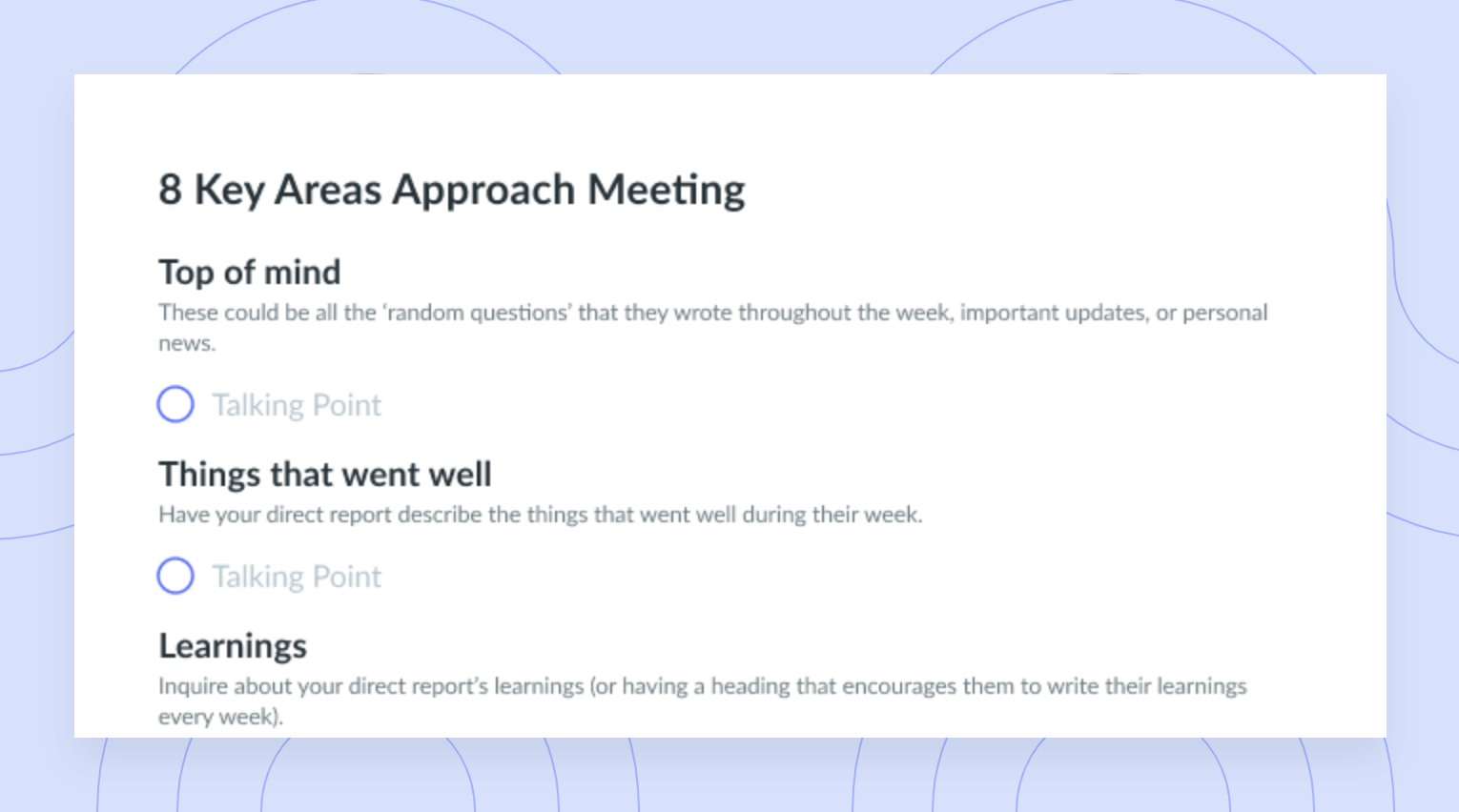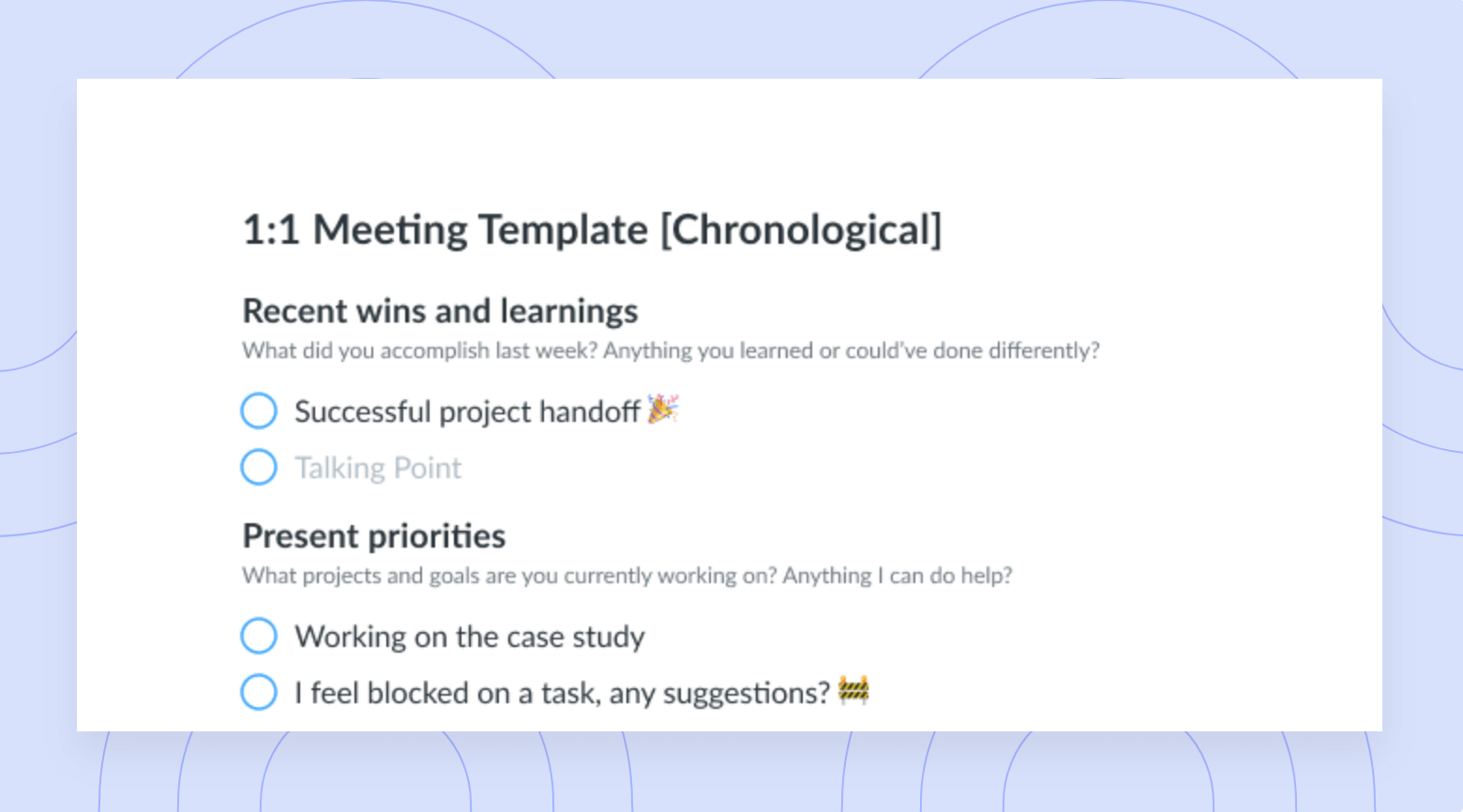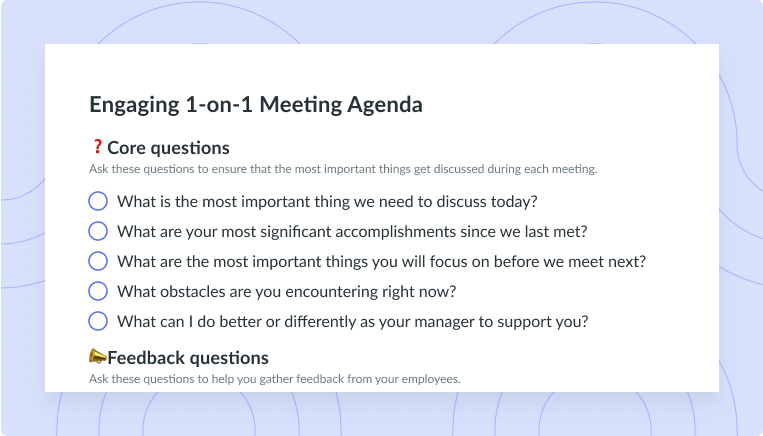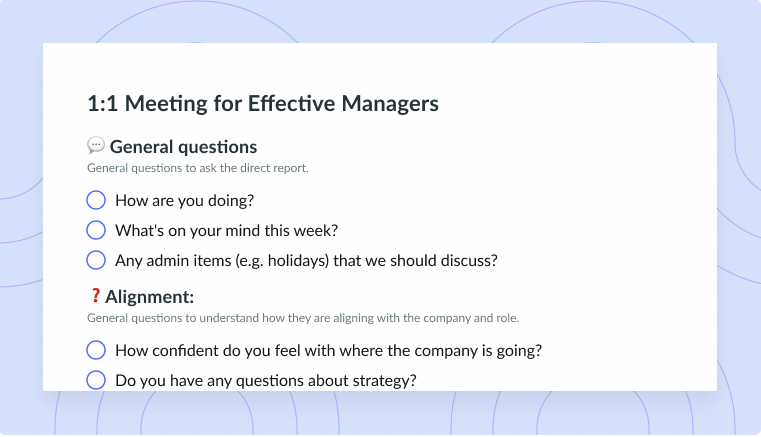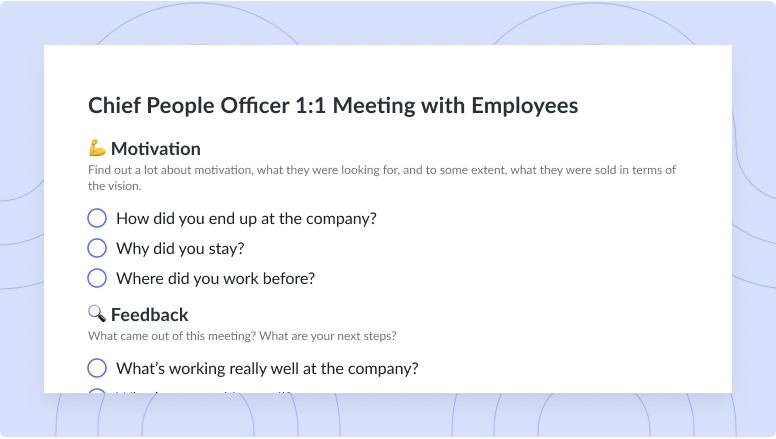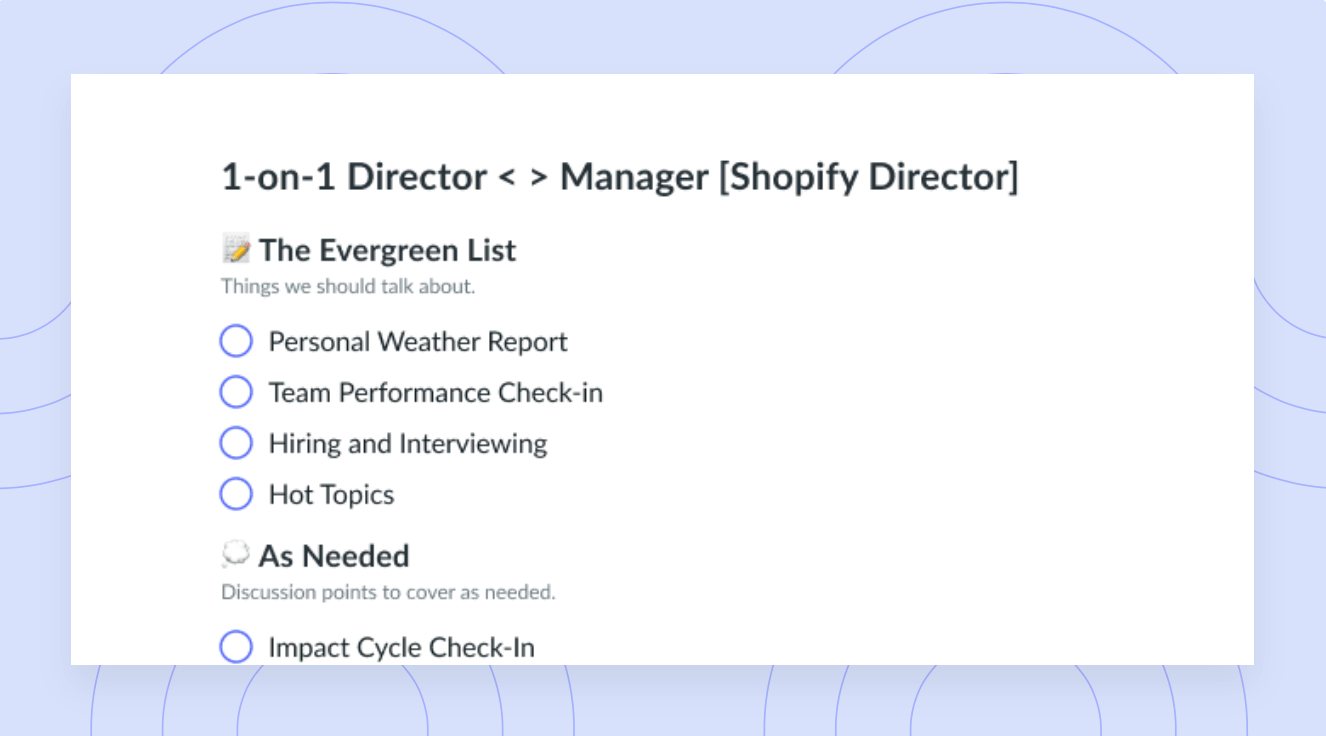The Benefits of 1-On-1 Meetings (+ Free Templates)
Here are 5 great benefits of one-on-one meetings and a few ways to make the most of them!
There are a lot of ways to refer to that regular check-in meeting you have with just one other person. Maybe you call it your “weekly sync up,” or your manager refers to it as a “scheduled touch-base call.” The more common name for this type of discussion is a one-on-one meeting. Whether this concept is new to you or you’re just looking for some new ways to improve your current one-on-one meetings, you’ve come to the right place! We’re covering some benefits of integrating one-to-one meetings into your schedule, we’ve outlined some common mistakes to avoid, and we’ve even put together a few meeting agenda templates for you to get started right away!
- Why are 1-on-1 meetings important?
- Benefits of 1-on-1 meetings
- What should be discussed during a 1-on-1 meeting?
- Common 1-on-1 mistakes to avoid
- How Fellow empowers 1-on-1 meetings
- Free 1:1 meeting templates
Why are 1-on-1 meetings important?
One-on-one meetings are most commonly used between managers and each of their direct reports. In this context, these meetings are important to discuss project challenges, share honest constructive feedback, and plan for career progression opportunities. Managers might also use this time to check in on an employee’s well-being to detect and prevent burnout early on or to discuss any personal matters that might be affecting an employee’s work life.
These meetings can also be important for peers who work closely on a project, for co-leaders of a department, or in mentorship relationships. In any context, a one-on-one meeting is an opportunity to converse on a more personal level on topics that individuals might not want to share in front of a group.

Great meetings are just the start
A well-run meeting can foster communication and collaboration by including an agenda the whole team can contribute to. Try using a tool like Fellow!
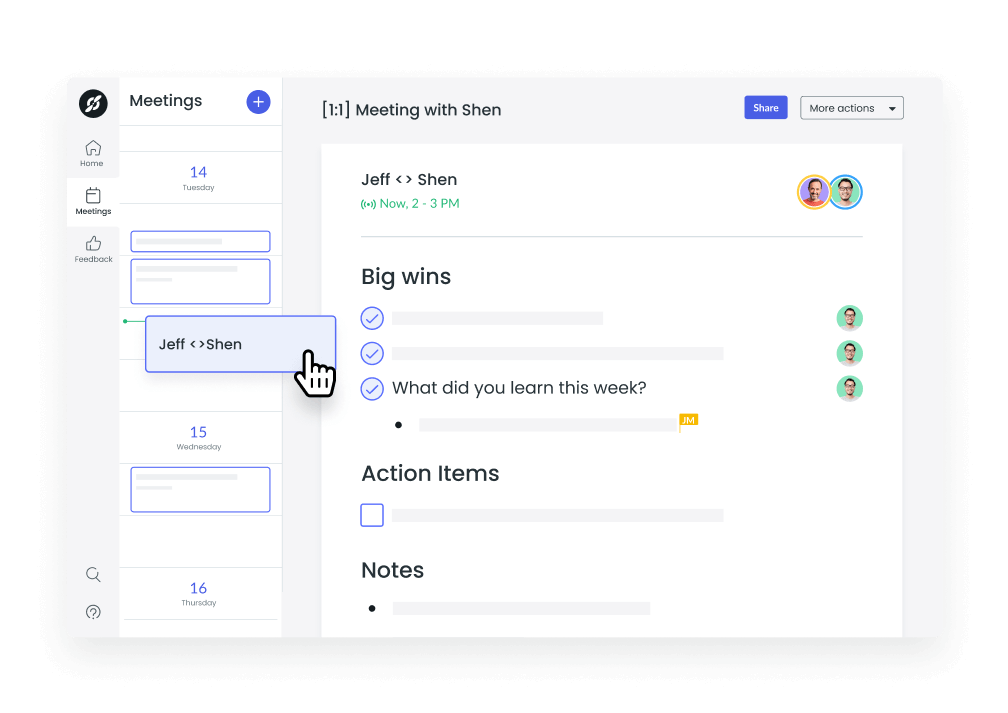
Benefits of 1-on-1 meetings
- Improves employee performance
- Builds trust
- Aligns teammates on progress
- Presents an opportunity for feedback
- Increases team agility
1 Improves employee performance
Isolating time to spend with each employee can help with their performance, and depending on which questions you use to guide your one-on-one, you can get a lot of different outputs. For example, having dedicated time to talk about career goals can help an employee feel more motivated and prepared to level up in their role. Or, asking about their work-life balance can help you see where they might be overloaded, and therefore not as productive as they could be. Great managers look to see growth fuelers and blockers to employee successes in advance and then use the one-on-one time to guide the employee on action plans toward improving performance.
2 Builds trust
One-on-ones help to make the employee feel heard about any challenges and goals on which they’re working. Employees can use this time to share any topic that’s top of mind, which can range from venting about a difficult customer conversation to just talking about how they’re excited about an upcoming vacation to relax their minds. Actively listening to an employee in these calls makes the employee feel trust in their manager as a great person to talk to in any time of need.
3 Aligns teammates on progress
Depending on the employee’s seniority or the scope of work they’re covering, one-on-one meetings might take place weekly, bi-weekly, or monthly. Regardless, these meetings are usually set at a specific frequency, making them a great way to check in on progress. Try using this meeting time to set personal or professional goals and help the employee build an action plan (including success metrics). At each one-on-one meeting, ask how they’re working towards those goals and if there’s any support that you, as the leader, can provide them to help them get there.
4 Presents an opportunity for feedback
Constructive feedback is necessary for a team, partnership, or business to function efficiently. Without really honest feedback cycles, it’s difficult to self-identify areas for improvement. These meetings are great for both employees and their managers to provide feedback to each other on recent projects, responses to something that’s occurred in the team, progression towards goals, or anything else that’s top of mind. When delivering feedback, always remember to be positive and constructive, provide a few examples where possible, and offer support for improvement going forward.
5 Increases team agility
Keeping one-on-one meetings on a scheduled basis means you won’t forget to check in on your direct report’s progress. Hosting these meetings more frequently, like every week, can also help new hires address questions and integrate into the team faster. For more seasoned employees, monthly or quarterly one-on-ones give them the time and space they need to act independently in their roles while still having support regularly.
What should be discussed during a 1-on-1 meeting?
The great thing about one-on-one meetings is how flexible they are to current needs and issues! There’s a huge range of topics that you could cover in this meeting, but some of the most common things to discuss include:
- Progress toward performance goals
- Professional skills development programs and targets
- Reflection on the overarching employee experience at the Company
- Resolution of issues within the company or project blockers
- Check-in on personal well-being and mental health
Common 1-on-1 mistakes to avoid
- Canceling or rescheduling frequently
- Driving the majority of the conversation
- Only talking about work
Canceling or rescheduling frequently
One-on-ones are a sacred meeting time between managers and employees because they are often the only time the pair get to bond outside of a group setting. Canceling or rescheduling these meetings shows that the relationship is less valuable than other priorities, which can decrease employee motivation and performance. It can also delay solutions to challenges that the employee is facing, leaving them to feel isolated, overburdened, and unsupported in their role.
As a solution, prioritize these meetings and only cancel if absolutely necessary. Choose a time in your calendar when you don’t regularly have other bookings or are likely to cancel. For example, Mondays and Fridays might not be the best time for one-on-ones as long weekends or extended holidays would force you to reschedule frequently. Additionally, avoid booking it immediately after other meetings that often go overtime, as it would risk your one-on-one having a late start.
Driving the majority of the conversation
This is a special time for employees to talk about their place within the company. Therefore, it makes sense for the direct report to guide the conversation. If the manager spends most of the meeting asking to update questions or going through their own planned talking points, it’s very possible that the meeting will end without hearing or addressing a major concern the direct report is facing.
Instead, the direct report should be taking the lead. It’s their time to ask questions or provide updates, and open up about how they’re currently feeling. As a manager, to ensure you’re not jumping into the driver’s seat, start the meeting by asking an open-ended question about what’s top of mind for the employee. Also, asking the employee to create their own meeting agenda talking points can help give them control over the meeting.
Only talking about work
While this alone time is certainly a great opportunity to talk about ongoing projects, only limiting your conversation points to work-related items can keep a manager and direct report from actually getting to know each other.
To help build trust, focus some of the conversations on getting to know each other, being vulnerable, and asking good questions. Some weeks, your one-on-one meetings might not even have a work-related element to them and that’s perfectly fine. The main goal of these meetings should be making sure your direct report feels heard and supported in their role, and that will happen in different ways depending on their needs at that time.
How Fellow empowers 1-on-1 meetings
Fellow is a one-on-one meeting software for managers to help organize these meetings with their team members. Managers can use Fellow to create a shared one-on-one document with each direct report containing details on career progression, current goals, challenges, action plans, or anything else discussed during the meetings. This document can be created as a collaborative meeting agenda for the direct report to add their own talking points ahead of each one-on-one meeting, too. Using a meeting agenda in this way builds a to-do list of talking points to guide the conversation. Managers can then edit notes in real-time during the meeting, create action items where necessary, and easily share the meeting report with the employee after the call.
Free 1:1 meeting templates
To help guide your first one-on-one meetings, we’ve created a few meeting agenda templates for you!

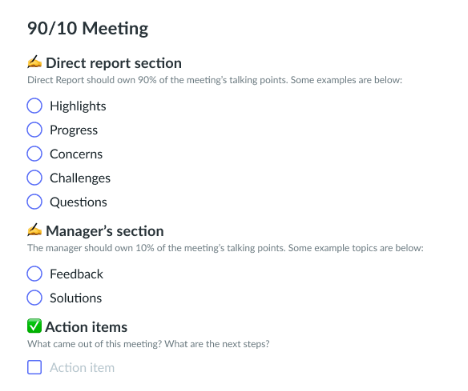
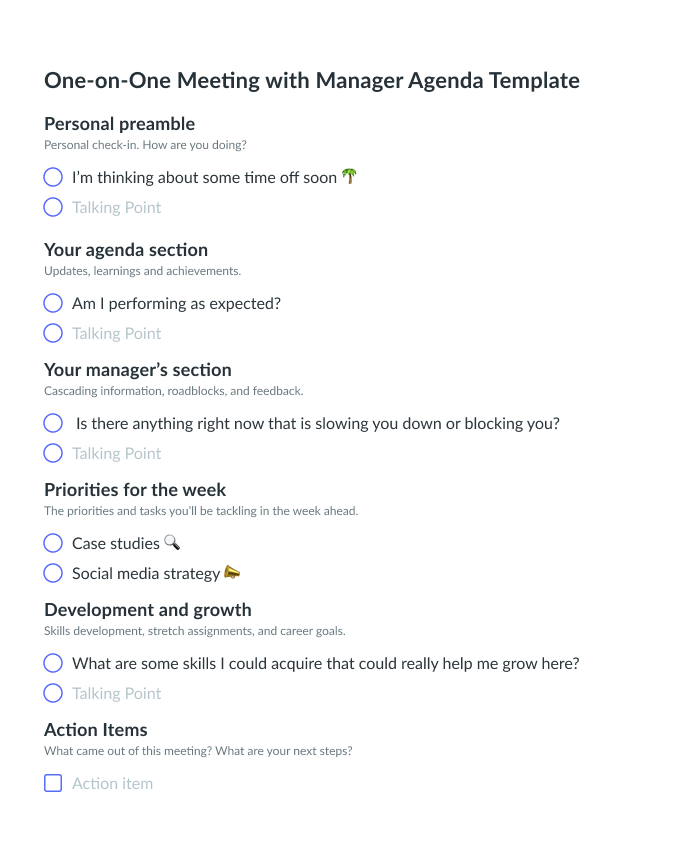
Parting advice
All in all, one-on-one meetings are a fantastic time to reconnect with each of your direct reports. In the average week or month, a lot of topics can accumulate as teams work through big projects and difficult stakeholder interactions, and manage their personal lives, too. Keeping a regularly scheduled meeting to check in brings a level of stability and support to help your direct reports flourish in their roles, as well as meet their personal and professional goals faster!



![7 Meetings Every CEO Should Lead [+ Free Templates]](https://fellow.app/wp-content/uploads/2022/08/Meetings-Every-CEO-Should-Lead-2.jpg)
![Hosting 1:1s as a CEO: 9 Best Practices [+ Free Templates]](https://fellow.app/wp-content/uploads/2023/01/Hosting-one-on-ones-as-a-CEO.jpg)


![COO Meeting Agenda: 6 Things to Include & Top Tips [+ Free Templates]](https://fellow.app/wp-content/uploads/2022/06/COO-Meeting.jpg)
![12 Ways to Inspire Creativity in the Workplace [+ FREE Templates]](https://fellow.app/wp-content/uploads/2022/06/Inspiring-Creativity-in-the-Workplace-2.jpg)
